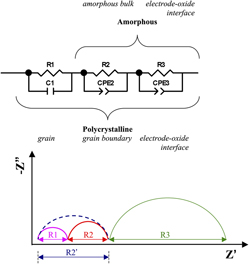Crossref Citations
This article has been cited by the following publications. This list is generated based on data provided by
Crossref.
Zhao, Yue
Phillips, Brian
Ozcelik, Damla
Parks, Joshua
Measor, Philip
Gulbransen, David
Schmidt, Holger
and
Hawkins, Aaron R.
2012.
Tailoring the spectral response of liquid waveguide diagnostic platforms.
Journal of Biophotonics,
Vol. 5,
Issue. 8-9,
p.
703.
Wiktorczyk, Tadeusz
and
Biegański, Piotr
2014.
Dielectric spectroscopy of electron beam deposited yttrium oxide films examined in metal–insulator–metal sandwich type structures.
Thin Solid Films,
Vol. 551,
Issue. ,
p.
188.
Kerasidou, A.
Karahaliou, P.
Xanthopoulos, N.
Svarnas, P.
Georga, S.
Krontiras, C.
and
Delaportas, D.
2014.
Electrical characteristics of Al<sub>2</sub>O<sub>3</sub> and Ta<sub>2</sub>O<sub>5</sub> nanoparticles synthesized by DC anodic ARC-discharge in water.
IEEE Transactions on Dielectrics and Electrical Insulation,
Vol. 21,
Issue. 1,
p.
230.
Kerasidou, A.P.
Karahaliou, P.K.
Xanthopoulos, N.I.
Svarnas, P.
Georga, S.N.
Krontiras, C.A.
and
Delaportas, D.
2014.
Electrical characteristics of Al2O3 and Ta2O5 nanoparticles synthesized by DC anodic ARC-discharge in water.
IEEE Transactions on Dielectrics and Electrical Insulation,
Vol. 21,
Issue. 1,
p.
230.
Dong, Cheng
Chen, Tianlan
Gao, Jie
Jia, Yanwei
Mak, Pui-In
Vai, Mang-I
and
Martins, Rui P.
2015.
On the droplet velocity and electrode lifetime of digital microfluidics: voltage actuation techniques and comparison.
Microfluidics and Nanofluidics,
Vol. 18,
Issue. 4,
p.
673.
Han, Chan Su
Choi, Hong Rak
Choi, Hong Je
and
Cho, Yong Soo
2017.
Origin of Abnormal Dielectric Behavior and Chemical States in Amorphous CaCu3Ti4O12 Thin Films on a Flexible Polymer Substrate.
Chemistry of Materials,
Vol. 29,
Issue. 14,
p.
5915.
Seisenbaeva, Gulaim A.
Cojocaru, Bogdan
Jurca, Bogdan
Tiseanu, Carmen
Nedelec, Jean‐Marie
Kessler, Vadim G.
and
Parvulescu, Vasile I.
2017.
Mesoporous Tantalum Oxide Photocatalyst: Structure and Activity Evaluation.
ChemistrySelect,
Vol. 2,
Issue. 1,
p.
421.
Albu, Camelia
Eremia, Sandra A.V.
Veca, Monica Lucia
Avram, Andrei
Popa, Radu Cristian
Pachiu, Cristina
Romanitan, Cosmin
Kusko, Mihaela
Gavrila, Raluca
and
Radoi, Antonio
2019.
Nano-crystalline graphite film on SiO2: Electrochemistry and electro-analytical application.
Electrochimica Acta,
Vol. 303,
Issue. ,
p.
284.
Schmitt, Rafael
Kubicek, Markus
Sediva, Eva
Trassin, Morgan
Weber, Mads C.
Rossi, Antonella
Hutter, Herbert
Kreisel, Jens
Fiebig, Manfred
and
Rupp, Jennifer L. M.
2019.
Accelerated Ionic Motion in Amorphous Memristor Oxides for Nonvolatile Memories and Neuromorphic Computing.
Advanced Functional Materials,
Vol. 29,
Issue. 5,
Xu, Qiyun
Ma, Yuanzhi
and
Skowronski, Marek
2020.
Nanoscale density variations in sputtered amorphous TaOx functional layers in resistive switching devices.
Journal of Applied Physics,
Vol. 127,
Issue. 5,
Xie, Juan
Liu, Hanxing
Yao, Zhonghua
Hao, Hua
Xie, Yanjiang
Li, Zongxin
and
Cao, Minghe
2020.
Performance optimization of Mg-rich bismuth-magnesium-titanium thin films for energy storage applications.
Journal of the European Ceramic Society,
Vol. 40,
Issue. 4,
p.
1243.
Hirpara, Jignesh
Chawla, Vipin
and
Chandra, Ramesh
2021.
Anticorrosive Behavior Enhancement of Stainless Steel 304 through Tantalum-Based Coatings: Role of Coating Morphology.
Journal of Materials Engineering and Performance,
Vol. 30,
Issue. 3,
p.
1895.
Sahoo, Kiran K
Pradhan, Diana
Ghosh, Surya P
Gartia, Anurag
and
Kar, Jyoti P
2024.
Modulation of electrical properties of sputtered Ta2O5 films by variation of RF power and substrate temperature.
Physica Scripta,
Vol. 99,
Issue. 2,
p.
025934.
Hu, Shengyong
Hu, Kuojuei
Zhang, Yongxin
Shah, Syed Adil
Zhao, Zixiang
Zuo, Zewen
Lu, Siqi
Tang, Sichen
Zhu, Wuwen
Fang, Liu
and
Song, Fengqi
2024.
Oxidation behavior and atomic structural transition of size-selected coalescence-resistant tantalum nanoclusters.
Nanotechnology,
Vol. 35,
Issue. 31,
p.
315603.
Stasner, P.
Hennen, T.
Gorbunova, E.
Garcia Munoz, A.
Waser, R.
and
Wouters, D. J.
2024.
Full factorial analysis of gradual switching in thermally oxidized memristive devices.
Journal of Applied Physics,
Vol. 135,
Issue. 23,
Syugaev, A. V.
and
Eryomina, M. A.
2024.
EIS Study of Oxide Layer in Porous Tantalum.
Russian Journal of Physical Chemistry A,
Vol. 98,
Issue. 10,
p.
2355.
